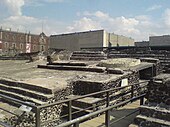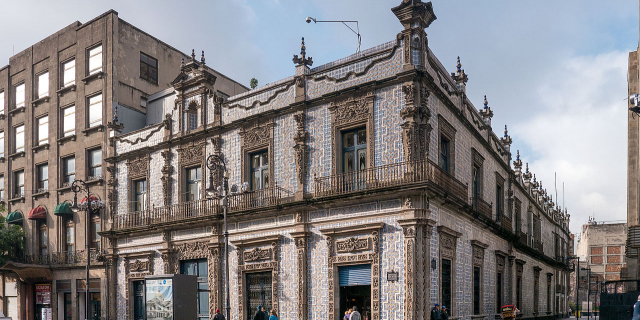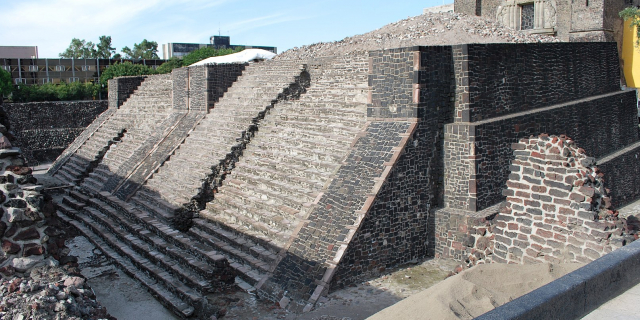México-Tenochtitlan
( Tenochtitlan )
Tenochtitlan, also known as Mexico-Tenochtitlan, was a large Mexican altepetl in what is now the historic center of Mexico City. The exact date of the founding of the city is unclear, but the date 13 March 1325 was chosen in 1925 to celebrate the 600th anniversary of the city. The city was built on an island in what was then Lake Texcoco in the Valley of Mexico. The city was the capital of the expanding Aztec Empire in the 15th century until it was captured by the Tlaxcaltec and the Spanish in 1521.
At its peak, it was the largest city in th...Read more
Tenochtitlan, also known as Mexico-Tenochtitlan, was a large Mexican altepetl in what is now the historic center of Mexico City. The exact date of the founding of the city is unclear, but the date 13 March 1325 was chosen in 1925 to celebrate the 600th anniversary of the city. The city was built on an island in what was then Lake Texcoco in the Valley of Mexico. The city was the capital of the expanding Aztec Empire in the 15th century until it was captured by the Tlaxcaltec and the Spanish in 1521.
At its peak, it was the largest city in the pre-Columbian Americas. It subsequently became a cabecera of the Viceroyalty of New Spain. Today, the ruins of Tenochtitlan are in the historic center of the Mexican capital. The World Heritage Site of Xochimilco contains what remains of the geography (water, boats, floating gardens) of the Mexica capital.
Tenochtitlan was one of two Mexica āltepētl (city-states or polities) on the island, the other being Tlatelolco.
 A Mexico City monument commemorating the foundation of Tenochtitlan
A Mexico City monument commemorating the foundation of TenochtitlanTenochtitlan was the capital of the Mexican civilization of the Mexica people, founded in 1325. The state religion of the Mexica civilization awaited the fulfillment of an ancient prophecy: the wandering tribes would find the destined site for a great city whose location would be signaled by an eagle with a snake in its beak perched atop a cactus (Opuntia), which had grown from the heart of Copil.[1][2]
The Mexica saw this vision on what was then a small swampy island in Lake Texcoco, a vision that is now immortalized in Mexico's coat of arms and on the Mexican flag. Not deterred by the unfavourable terrain, they set about building their city, using the chinampa system (misnamed as "floating gardens") for agriculture and to dry and expand the island.
A thriving culture developed, and the Mexica civilization came to dominate other tribes around Mexico. The small natural island was perpetually enlarged as Tenochtitlan grew to become the largest and most powerful city in Mesoamerica. Commercial routes were developed that brought goods from places as far as the Gulf of Mexico, the Pacific Ocean and perhaps even the Inca Empire.[3]
After a flood of Lake Texcoco, the city was rebuilt during the rule of Ahuitzotl, which was between 1486 and 1502, in a style that made it one of the grandest ever in Mesoamerica.
Spanish conquistador Hernán Cortés arrived in Tenochtitlan on 8 November 1519. Although there are not precise numbers, the city's population has been estimated at between 200,000 and 400,000 inhabitants,[4] placing Tenochtitlan among the largest cities in the world at that time.[5] Compared to the cities of Europe, only Paris, Venice and Constantinople might have rivaled it. It was five times the size of the London of Henry VIII.[6] In a letter to the Spanish king, Cortés wrote that Tenochtitlan was as large as Seville or Córdoba. Cortes' men were in awe at the sight of the splendid city and many wondered if they were dreaming.[7]
Although some popular sources put the number as high as 350,000,[8] the most common estimates of the population are of over 200,000 people. One of the few comprehensive academic surveys of Mesoamerican city and town sizes arrived at a population of 212,500 living on 13.5 km2 (5.2 sq mi).[9] It is also said that at one time, Moctezuma had rule over an empire of almost five million people in central and southern Mexico because he had extended his rule to surrounding territories to gain tribute and prisoners to sacrifice to the gods.[10]
Conquest The Conquest of Tenochtitlan
The Conquest of TenochtitlanWhen Cortés and his men invaded Tenochtitlan, Moctezuma II chose to welcome Cortés as an ambassador rather than risk a war which might quickly be joined by aggrieved indigenous people.
As Cortés approached Tenochtitlan, the Tenochcah celebrated Toxcatl. At this event the most prominent warriors of altepetl[clarification needed] would dance in front of a huge statue of Huitzilopochtli. The Spanish leader, Pedro de Alvarado, who was left in charge, worried that the natives planned a surprise attack. He captured three natives and tortured them until they said that this[clarification needed] was indeed true. During the festival, the Spaniards came heavily armed and closed off every exit from the courtyard so that no one would escape. This happened during their last days in Tenochtitlan.[11]
Nobles lined each side of the city's main causeway, which extended about a league. Walking down the center came Moctezuma II, with two lords at his side, one his brother, the ruler of Iztapalapa. Cortés dismounted and was greeted by the ruler and his lords, but forbidden to touch him. Cortés gave him a necklace of crystals, placing it over his neck.[12]
 Mexica pyramid of Ehecatl in the Metro Pino Suárez station, Mexico City Subway.
Mexica pyramid of Ehecatl in the Metro Pino Suárez station, Mexico City Subway.They were then brought to a large house that would serve as their home for their stay in the city. Once they were settled, Moctezuma himself sat down and spoke with Cortés. The great ruler declared that anything that they needed would be theirs to have.[13] He was thrilled to have visitors of such stature. Although the Spaniards were seeking gold, Moctezuma expressed that he had very little of the sort, but all of it was to be given to Cortés if he desired it.[14]
Soon after arriving in Tenochtitlan, Cortés came up against problems. At Vera Cruz, the officer left in charge received a letter from Qualpopoca, the leader of Nueva Almería, asking to become a vassal of the Spaniards. He requested that officials be sent to him so that he could confirm his submission. To reach the province, the officers would have to travel through hostile land. The officer in charge of Vera Cruz decided to send four officers to meet with Qualpopoca.[15]
When they arrived, they were captured and two were killed, the other two escaping through the woods. Upon their return to Vera Cruz, the officer in charge was infuriated, and led troops to storm Almería. Here they learned that Moctezuma was supposedly the one who ordered the officers executed.[16] Back in Tenochtitlan, Cortés detained Moctezuma and questioned him.[17] Though no serious conclusions were reached, this negatively affected the relationship between Moctezuma and the Spaniards.[18]
Cortés subsequently besieged Tenochtitlan for over 90 days, causing a famine.[10] Having gained control, he then directed the systematic destruction and leveling of the city;[19] and began its rebuilding, despite opposition. The reconstruction involved the creation of a central area designated for Spanish use (the traza). The outer Indian section, now dubbed San Juan Tenochtitlan, continued to be governed by the previous indigenous elite and was divided into the same subdivisions as before.[20]
The people of Tenochtitlan were soon exposed to diseases to which they had no immunity. Symptoms were often delayed for up to ten days, when the infection would spread throughout the body, causing sores, pain, and high fever. People were weak to the point that they could not move, nor obtain food and water. Burial of the dead become difficult to impossible, due to the pervasiveness of the people's illness. The people of Tenochtitlan began to starve and weaken. The death toll rose steadily over the course of the next 60 days.[21][when?][clarification needed]
Colonial era Districts of Tenochtitlan overlaid on a map of modern streets of Mexico City, with the traza shown in gray
Districts of Tenochtitlan overlaid on a map of modern streets of Mexico City, with the traza shown in grayCortés founded the Spanish capital of Mexico City on the ruins of Tenochtitlan. Despite the extensive damage to the built environment, the site retained symbolic power and legitimacy as the capital of the Aztec empire, which Cortés sought to appropriate. For a time this ciudad de españoles, the highest rank in the Spanish hierarchy of settlement designation, was called Mexico–Tenochtitlan. Charles Gibson devotes the final chapter of his classic work, The Aztecs Under Spanish Rule, to what he called "The City",[22] with later historians building on his work.[23] The Spaniards established a cabildo or town council, which had jurisdiction over the Spanish residents. The Spanish established a Europeans-only zone in the center of the city, an area of 13 blocks in each direction of the central plaza, which was the traza. Although many native residents died during the siege of Tenochtitlan, the indigenous still had a strong presence in the city, and were settled in two main areas of the island, designated San Juan Tenochtitlan and Santiago Tlatelolco, each with a municipal council that functioned the entire colonial period. San Juan Tenochtitlan was a Spanish administrative creation, which amalgamated four indigenous sections, with each losing territory to the Spanish traza. The Spanish laid out the streets of the traza in a checker board pattern, with straight streets and plazas at intervals, whereas the indigenous portions of the city were irregular in layout and built of modest materials. In the colonial period both San Juan Tenochtitlan and Santiago Tlatelolco retained jurisdiction over settlements on the mainland that they could draw on for labor and tribute demanded by the Spanish, but increasingly those subordinate settlements (sujetos) were able to gain their autonomy with their own rulers and separate relationship with the Spanish rulers.[24] Concern about the health of the indigenous population in early post-conquest Mexico–Tenochtitlan led to the founding of a royal hospital for indigenous residents.[25]
There are a number of colonial-era pictorial manuscripts dealing with Tenochtitlan–Tlatelolco, which shed light on litigation between Spaniards and indigenous over property.[26] An account with information about the war of Tenochtitlan against its neighbor Tlatelolco in 1473 and the Spanish conquest in 1521 is the Anales de Mexico y Tlatelolco, 1473, 1521–22.[27] Anthropologist Susan Kellogg has studied colonial-era inheritance patterns of Nahuas in Mexico City, using Nahuatl- and Spanish-language testaments.[28] On the 13th of August 1521, after over two months of fighting,Spanish conquistador Hernán Cortés succeeded in bringing about the fall of Tenochtitlan, the capital of the Aztec empire, and consequently brought an end to the Aztec empire
Ruins The Templo Mayor in Mexico-Tenochtitlan, the Aztec capital.
The Templo Mayor in Mexico-Tenochtitlan, the Aztec capital. Templo Mayor of Mexico-Tenochtitlan ruins.
Templo Mayor of Mexico-Tenochtitlan ruins. The ruins of the Templo Mayor
The ruins of the Templo Mayor Fundación de México (The foundation of Mexico) – Tenochtitlán by Roberto Cueva del Río
Fundación de México (The foundation of Mexico) – Tenochtitlán by Roberto Cueva del RíoTenochtitlan's main temple complex, the Templo Mayor, was dismantled and the central district of the Spanish colonial city was constructed on top of it. The great temple was destroyed by the Spanish during the construction of a cathedral. The location of the Templo Mayor was rediscovered in the early 20th century, but major excavations did not take place until 1978–1982, after utility workers came across a massive stone disc depicting the nude dismembered body of the moon goddess Coyolxauhqui. The disc is 3.25 meters (10 ft 8 in) in diameter, and is held at the Templo Mayor Museum.[29]
The ruins, constructed over seven periods, were built on top of each other. The resulting weight of the structures caused them to sink into the sediment of Lake Texcoco; the ruins now rest at an angle instead of horizontally.
Mexico City's Zócalo, the Plaza de la Constitución, is located at the site of Tenochtitlan's original central plaza and market, and many of the original calzadas still correspond to modern city streets. The Aztec calendar stone was located in the ruins. This stone is 4 meters (13 ft 1 in) in diameter and weighs over 18.1 metric tons (20 short tons; 17.9 long tons). It was once located half-way up the great pyramid. This sculpture was carved around 1470 under the rule of King Axayacatl, the predecessor of Tizoc, and is said to tell the history of the Mexicas and to prophesy the future.[30]
In August 1987, archaeologists discovered a mix of 1,789 human bones five meters (16 ft 5 in) below street level in Mexico City.[31] The burial dates back to the 1480s and lies at the foot of the main temple in the sacred ceremonial precinct of the Aztec capital. The bones are from children, teenagers and adults. A complete skeleton of a young woman was also found at the site.[31]

































Add new comment